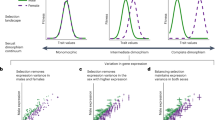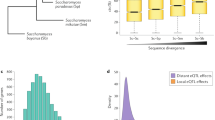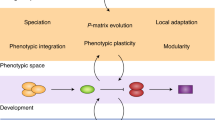Abstract
The profound differences in gene expression between the sexes are increasingly used to study the molecular basis of sexual dimorphism, sexual selection and sexual conflict. Studies of transcriptional architecture, based on comparisons of gene expression, have also been implemented for a wide variety of other intra-specific polymorphisms. These efforts are based on key assumptions regarding the relationship between transcriptional architecture, phenotypic variation and the target of selection. Some of these assumptions are better supported by available evidence than others. In all cases, the evidence is largely circumstantial, leaving considerable gaps in our understanding of the relationship between transcriptional and phenotypic dimorphism.
This is a preview of subscription content, access via your institution
Access options
Access Nature and 54 other Nature Portfolio journals
Get Nature+, our best-value online-access subscription
$29.99 / 30 days
cancel any time
Subscribe to this journal
Receive 12 digital issues and online access to articles
$119.00 per year
only $9.92 per issue
Buy this article
- Purchase on Springer Link
- Instant access to full article PDF
Prices may be subject to local taxes which are calculated during checkout


Similar content being viewed by others
References
Linnen, C. R. et al. Adaptive evolution of multiple traits through multiple mutations at a single gene. Science 339, 1312–1316 (2013).
Shapiro, M. D. et al. Genetic and developmental basis of evolutionary pelvic reduction in threespine sticklebacks. Nature 428, 717–723 (2004).
Chen, Y. C. et al. Expression change in Angiopoietin-1 underlies change in relative brain size in fish. Proc. R. Soc. B 282, 9 (2015).
Khila, A., Abouheif, E. & Rowe, L. Function, developmental genetics, and fitness consequences of a sexually antagonistic trait. Science 336, 585–589 (2012).
Colombo, M. et al. The ecological and genetic basis of convergent thick-lipped phenotypes in cichlid fishes. Mol. Ecol. 22, 670–684 (2013).
Manousaki, T. et al. Parsing parallel evolution: ecological divergence and differential gene expression in the adaptive radiations of thick-lipped Midas cichlid fishes from Nicaragua. Mol. Ecol. 22, 650–669 (2013).
Ferreira, P. G. et al. Transcriptome analyses of primitively eusocial wasps reveal novel insights into the evolution of sociality and the origin of alternative phenotypes. Genome Biol. 14, R20 (2013).
Hunt, B. G. et al. Relaxed selection is a precursor to the evolution of phenotypic plasticity. Proc. Natl Acad. Sci. USA 108, 15936–15941 (2011).
Patalano, S. et al. Molecular signatures of plastic phenotypes in two eusocial insect species with simple societies. Proc. Natl Acad. Sci. USA 112, 13970–13975 (2015).
Ghalambor, C. K. et al. Non-adaptive plasticity potentiates rapid adaptive evolution of gene expression in nature. Nature 525, 372–375 (2015).
Darwin, C. The Descent of Man, and Selection in Relation to Sex (Murray, 1871).
Lande, R. Sexual dimorphism, sexual selection and adaptation in polygenic characters. Evolution 34, 292–305 (1980).
Rice, W. R. Sex chromosomes and the evolution of sexual dimorphism. Evolution 38, 735–742 (1984).
Bachtrog, D. et al. Sex determination: why so many ways of doing it?. PLoS Biol. 12, e101899 (2014).
Hollis, B., Houle, D., Yan, Z., Kawecki, T. J. & Keller, L. Evolution under monogamy feminizes gene expression in Drosophila melanogaster. Nat. Commun. 5, 3482 (2014).
Innocenti, P. & Morrow, E. H. The sexually antagonistic genes of Drosophila melanogaster. PLoS Biol. 8, e1000355 (2010).
Stuglik, M. T., Babik, W., Prokop, Z. & Radwan, J. Alternative reproductive tactics and sex-biased gene expression: the study of the bulb mite transcriptome. Ecol. Evol. 4, 623–632 (2014).
Harrison, P. W. et al. Sexual selection drives evolution and rapid turnover of male gene expression. Proc. Natl Acad. Sci. USA 112, 4393–4398 (2015).
Pointer, M. A., Harrison, P. W., Wright, A. E. & Mank, J. E. Masculinization of gene expression is associated with exaggeration of male sexual dimorphism. PLoS Genet. 9, e1003697 (2013).
Gossmann, T. I., Schmid, M. W., Grossniklaus, U. & Schmid, K. J. Selection-driven evolution of sex-biased genes is consistent with sexual selection in Arabidopsis thaliana. Mol. Biol. Evol. 31, 574–583 (2014).
Zemp, N., Tavares, R. & Widmer, A. Fungal infection induces sex-specific transcriptional changes and alters sexual dimorphism in the dioecious plant Silene latifolia. PLoS Genet. 11, e1005536 (2015).
Whittle, C. A. & Johannesson, H. Evolutionary dynamics of sex-biased genes in a hermaphrodite fungus. Mol. Biol. Evol. 30, 2435–2446 (2013).
Lipinska, A. et al. Sexual dimorphism and the evolution of sex-biased gene expression in the brown alga Ectocarpus. Mol. Biol. Evol. 32, 1581–1597 (2015).
Mank, J. E., Nam, K., Brunstrom, B. & Ellegren, H. Ontogenetic complexity of sexual dimorphism and sex-specific selection. Mol. Biol. Evol. 27, 1570–1578 (2010).
Zhang, Y., Sturgill, D., Parisi, M., Kumar, S. & Oliver, B. Constraint and turnover in sex-biased gene expression in the genus Drosophila. Nature 450, 233–237 (2007).
Mank, J. E., Hultin-Rosenberg, L., Axelsson, E. & Ellegren, H. Rapid evolution of female-biased, but not male-biased, genes expressed in the avian brain. Mol. Biol. Evol. 24, 2698–2706 (2007).
Yang, X. et al. Tissue-specific expression and regulation of sexually dimorphic genes in mice. Genome Res. 16, 995–1004 (2006).
Mank, J. E., Hultin-Rosenberg, L., Webster, M. T. & Ellegren, H. The unique genomic properties of sex-biased genes: insights from avian microarray data. BMC Genomics 9, 148 (2008).
Perry, J. C., Harrison, P. W. & Mank, J. E. The ontogeny and evolution of sex-biased gene expression in Drosophila melanogaster. Mol. Biol. Evol. 31, 1206–1219 (2014).
Wyman, M. J., Agrawal, A. F. & Rowe, L. Condition-dependence of the sexually dimorphic transcriptome in Drosophila melanogaster. Evolution 64, 1836–1848 (2010).
Emlen, D. J., Warren, I. A., Johns, A., Dworkin, I. & Lavine, L. C. A mechanism of extreme growth and reliable signaling in sexually selected ornaments and weapons. Science 337, 860–864 (2012).
Connallon, T. & Clark, A. G. Association between sex-biased gene expression and mutations with sex-specific phenotypic consequences in Drosophila. Genome Biol. Evol. 3, 151–155 (2011).
Mackay, T. F. C., Stone, E. A. & Ayroles, J. F. The genetics of quantitative traits: challenges and prospects. Nat. Rev. Genet. 10, 565–577 (2009).
Ober, C., Loisel, D. A. & Gilad, Y. Sex-specific genetic architecture of human disease. Nat. Rev. Genet. 9, 911–922 (2008).
Randall, J. C. et al. Sex-stratified genome-wide association studies including 270,000 individuals show sexual dimorphism in genetic loci for anthropometric traits. PLoS Genet. 9, e1003500 (2013).
Winkler, T. W. et al. The influence of age and sex on genetic associations with adult body size and shape: a large-scale genome-wide interaction study. PLoS Genet. 11, e1005378 (2015).
Derome, N. et al. Pervasive sex-linked effects on transcription regulation as revealed by expression quantitative trait loci mapping in lake whitefish species pairs (Coregonus sp., sahnonidae). Genetics 179, 1903–1917 (2008).
Van Nas, A. et al. Expression quantitative trait loci: replication, tissue- and sex-specificity in mice. Genetics 185, 1059–1068 (2010).
Whiteley, A. R. et al. The phenomics and expression quantitative trait locus mapping of brain transcriptomes regulating adaptive divergence in lake whitefish species pairs (Coregonus sp.). Genetics 180, 147–164 (2008).
Kirkpatrick, M. & Hall, D. W. Sexual selection and sex linkage. Evolution 58, 683–691 (2004).
Reeve, H. K. & Pfennig, D. W. Genetic biases for showy males: are some genetic systems especially conducive to sexual selection? Proc. Natl Acad. Sci. USA 100, 1089–1094 (2003).
Slate, J. From Beavis to beak color: a simulation study to examine how much QTL mapping can reveal about the genetic architecture of quantitative traits. Evolution 67, 1251–1262 (2013).
Badyaev, A. V. Growing apart: an ontogenetic perspective on the evolution of sexual size dimorphism. Trends Ecol. Evol. 17, 369–378 (2002).
Tang, F. C. et al. mRNA-Seq whole-transcriptome analysis of a single cell. Nat. Methods 6, 377–382 (2009).
Stulp, G., Barrett, L., Tropf, F. C. & Mills, M. Does natural selection favour taller stature among the tallest people on earth?. Proc. R. Soc. B 282, 20150211 (2015).
Delph, L. F., Steven, J. C., Anderson, I. A., Herlihy, C. R. & Brodie, E. D. Elimination of a genetic correlation between the sexes via artificial correlation selection. Evolution 65, 2872–2880 (2011).
Gosden, T. P. & Chenoweth, S. F. The evolutionary stability of cross-sex, cross-trait genetic correlations. Evolution 68, 1687–1697 (2014).
Stearns, S. C., Govindaraju, D. R., Ewbank, D. & Byars, S. G. Constraints on the coevolution of contemporary human males and females. Proc. R. Soc. B 279, 4836–4844 (2012).
Fairbairn, D. J., Blanckenhorn, W. & Szekeley, T. Sex, Size and Gender Roles: Evolutionary Studies of Sexual Size Dimorphism (Oxford Univ. Press, 2007).
Lande, R. The genetic covariance between characters maintained by pleiotropic mutations. Genetics 94, 203–215 (1980).
Griffin, R. M., Dean, R., Grace, J. L., Ryden, P. & Friberg, U. The shared genome is a pervasive constraint on the evolution of sex-biased gene expression. Mol. Biol. Evol. 30, 2168–2176 (2013).
Connallon, T. & Knowles, L. L. Intergenomic conflict revealed by patterns of sex-biased gene expression. Trends Genet. 21, 495–499 (2005).
Ellegren, H. & Parsch, J. The evolution of sex-biased genes and sex-biased gene expression. Nat. Rev. Genet. 8, 689–698 (2007).
Ament, S. A., Corona, M., Pollock, H. S. & Robinson, G. E. Insulin signaling is involved in the regulation of worker division of labor in honey bee colonies. Proc. Natl Acad. Sci. USA 105, 4226–4231 (2008).
Smith, C. R., Toth, A. L., Suarez, A. V. & Robinson, G. E. Genetic and genomic analyses of the division of labour in insect societies. Nat. Rev. Genet. 9, 735–748 (2008).
Whitfield, C. W., Cziko, A. M. & Robinson, G. E. Gene expression profiles in the brain predict behavior in individual honey bees. Science 302, 296–299 (2003).
Windig, J. J., Brakefield, P. M., Reitsma, N. & Wilson, J. G. M. Seasonal polyphenism in the wild: survey of wing patterns in five species of Bicyclus butterflies in Malawi. Ecol. Entomol. 19, 285–298 (2008).
Connallon, T. & Clark, A. G. Sex linkage, sex-specific selection and the role of recombination in the evolution of sexually dimorphic gene expression. Evolution 64, 3417–3442 (2010).
Dean, R. & Mank, J. E. Tissue-specificity and sex-specific regulatory variation permits the evolution of sex-biased gene expression. Am. Nat. 188, E74–E84 (2016).
Mank, J. E., Hultin-Rosenberg, L., Zwahlen, M. & Ellegren, H. Pleiotropic constraint hampers the resolution of sexual antagonism in vertebrate gene expression. Am. Nat. 171, 35–43 (2008).
Meisel, R. P. Towards a more nuanced understanding of the relationship between sex-biased gene expression and rates of protein-coding sequence evolution. Mol. Biol. Evol. 28, 1893–1900 (2011).
Jaquiery, J. et al. Masculinization of the X chromosome in the pea aphid. PLoS Genet. 9, e1003690 (2013).
Khil, P. P., Smirnova, N. A., Romanienko, P. J. & Camerini-Otero, R. D. The mouse X chromosome is enriched for sex-biased genes not subject to selection by meiotic sex chromosome inactivation. Nat. Genet. 36, 642–646 (2004).
Sturgill, D., Zhang, Y., Parisi, M. & Oliver, B. Demasculinization of X chromosomes in the Drosophila genus. Nature 450, 238–241 (2007).
Meisel, R. P., Malone, J. H. & Clark, A. G. Disentangling the relationship between sex-biased gene expression and X-linkage. Genome Res. 22, 1255–1265 (2012).
Mank, J. E. & Ellegren, H. Sex-linkage of sexually antagonistic genes is predicted by female, but not male, effects in birds. Evolution 63, 1464–1472 (2009).
Prince, E. G., Kirkland, D. & Demuth, J. P. Hyperexpression of the X chromosome in both sexes results in extensive female-bias of X-linked genes in the flour beetle. Genome Biol. Evol. 2, 336–346 (2010).
Wright, A. E., Moghadam, H. K. & Mank, J. E. Trade-off between selection for dosage compensation and masculinization on the avian Z chromosome. Genetics 192, 1433–1445 (2012).
Wright, A. E., Zimmer, F., Harrison, P. W. & Mank, J. E. Conservation of regional variation in sex-specific sex chromosome regulation. Genetics 201, 587–598 (2015).
Moghadam, H. K., Pointer, M. A., Wright, A. E., Berlin, S. & Mank, J. E. W chromosome expression responds to female-specific selection. Proc. Natl Acad. Sci. USA 109, 8207–8211 (2012).
Immonen, E., Snook, R. R. & Ritchie, M. G. Mating system variation drives rapid evolution of the female transcriptome in Drosophila pseudoobscura. Ecol. Evol. 4, 2186–2201 (2014).
Seddon, N. et al. Sexual selection accelerates signal evolution during speciation in birds. Proc. R. Soc. B 280, 20131065 (2013).
Ometto, L., Shoemaker, D., Ross, K. G. & Keller, L. Evolution of gene expression in fire ants: the effects of developmental stage, caste, and species. Mol. Biol. Evol. 28, 1381–1392 (2011).
Brawand, D. et al. The evolution of gene expression levels in mammalian organs. Nature 478, 343–348 (2011).
Shapiro, M. D., Bell, M. A. & Kingsley, D. M. Parallel genetic origings of pelvic reductions in vertebrates. Proc. Natl Acad. Sci. USA 103, 13573–13758 (2006).
Brakefield, P. M. et al. Development, plasticity and evolution of butterfly eyespot patterns. Nature 384, 236–242 (1996).
Blows, M. W., Alen, S. L., Collet, J. M., Chenoweth, S. F. & McGuigan, K. The phenome-wide distribution of genetic variance. Am. Nat. 186, 15–30 (2015).
Collet, J. M. Transcriptome-wide effects of seuxal selection on the fate of new mutations. Evolution 96, 2905–2916 (2015).
McGuigan, K., Aguirre, J. D. & Blows, M. W. Simultaneous estimation of additive and mutational genetic variance in an outbred population of Drosophila serrata. Genetics 201, 1239–1251 (2015).
Gompel, N., Prud'homme, B., Wittkopp, P. J., Kassner, V. A. & Carroll, S. B. Chance caught on the wing: cis-regulatory evolution and the origin of pigment patterns in Drosophila. Nature 433, 481–487 (2005).
Prud'homme, B. et al. Repeated morphological evolution through cis-regulatory changes in a pleiotropic gene. Nature 440, 1050–1053 (2006).
Blekhman, R., Marioni, J. C., Zumbo, P., Stephens, M. & Gilad, Y. Sex-specific and lineage-specific alternative splicing in primates. Genome Res. 20, 180–189 (2010).
Mullon, C., Wright, A. E., Reuter, M., Pomiankowski, A. & Mank, J. E. Evolution of dosage compensation under sexual selection differs between X and Z chromosomes. Nat. Commun. 6, 7720 (2015).
Locke, A. E. et al. Genetic studies of body mass index yield new insights for obesity biology. Nature 518, 197–206 (2015).
Wen, W. Q. et al. Meta-analysis of genome-wide association studies in East Asian-ancestry populations identifies four new loci for body mass index. Human Mol. Genet. 23, 5492–5504 (2014).
Wood, A. R. et al. Defining the role of common variation in the genomic and biological architecture of adult human height. Nat. Genet. 46, 1173–1186 (2014).
Yao, C. et al. Sex- and age-interacting eQTLs in human complex diseases. Human mol. Genet. 23, 1947–1956 (2014).
Ranz, J. M., Castillo-Davis, C. I., Meiklejohn, C. D. & Hartl, D. L. Sex-dependent gene expression and evolution of the Drosophila transcriptome. Science 300, 1742–1745 (2003).
Zhang, Z., Hambuch, T. M. & Parsch, J. Molecular evolution of sex-biased genes in Drosophila. Mol. Biol. Evol. 21, 2130–2139 (2004).
Pal, C., Papp, B. & Hurst, L. D. Highly expressed genes in yeast evolve slowly. Genetics 158, 927–931 (2001).
Urrutia, A. O. & Hurst, L. D. The signature of selection mediated by expression on human genes. Genome Res. 13, 2260–2264 (2003).
Andersson, M. Sexual Selection (Princeton Univ. Press, 1994).
Lande, R. Models of speciation by sexual selection on polygenic traits. Proc. Natl Acad. Sci. USA 78, 3721–3725 (1981).
Proschel, M., Zhang, Z. & Parsch, J. Widespread adaptive evolution of Drosophila genes with sex-biased expression. Genetics 174, 893–900 (2006).
Khaitovich, P. et al. Parallel patterns of evolution in the genomes and transcriptomes of humans and chimpanzees. Science 309, 1850–1854 (2005).
Cutter, A. D. & Ward, S. Sexual and temporal dynamics of molecular evolution in C. elegans development. Mol. Biol. Evol. 22, 178–188 (2005).
Gershoni, M. & Pietrokovski, S. Reduced selection and accumulation of deleterious mutations in genes expressed exclusively in men. Nat. Commun. 5 4438 (2014).
Dapper, A. L., Wade, M. J. The evolution of sperm competition genes: the effect of mating system on levels of genetic variation within and between species. Evolution 70, 502–511 (2016).
Cobbs, G. Multiple inseminations and male sexual selection in natural populations of Drosophila pseudoobscura. Am. Nat. 111, 641–656 (1977).
Smith, N. G. C. & Eyre-Walker, A. Adaptive protein evolution in Drosophila. Nature 415, 1022–1024 (2002).
Wyman, M. J., Cutter, A. D. & Rowe, L. Gene duplication in the evolution of sexual dimorphism. Evolution 66, 1556–1566 (2012).
Montgomery, S. H. & Mank, J. E. Inferring regulatory change from gene expression: the confounding effects of tissue scaling. Mol. Ecol. http://dx.doi.org/10.1111/mec.13824 (2016).
Voje, K. L. Scaling of morphological characters across trait type, sex, and environment: a meta-analysis of static allometries. Am. Nat. 187, 89–98 (2016).
Gur, R. C. et al. Sex differences in brain gray and white matter in healthy young adults: correlations with cognitive performance. J. Neurosci. 15, 4065–4072 (1999).
Acknowledgements
I am extremely grateful for generous support from the European Research Council (grant agreements 260233 and 680951), and discussion of these topics over the past few years with members of the lab, particularly R. Dean, A. Wright, V. Oostra, S. Montgomery and N. Block.
Author information
Authors and Affiliations
Corresponding author
Ethics declarations
Competing interests
The author declares no competing financial interests.
Rights and permissions
About this article
Cite this article
Mank, J. The transcriptional architecture of phenotypic dimorphism. Nat Ecol Evol 1, 0006 (2017). https://doi.org/10.1038/s41559-016-0006
Received:
Accepted:
Published:
DOI: https://doi.org/10.1038/s41559-016-0006
This article is cited by
-
The roles of sexual selection and sexual conflict in shaping patterns of genome and transcriptome variation
Nature Ecology & Evolution (2023)
-
Sex-specific morphs: the genetics and evolution of intra-sexual variation
Nature Reviews Genetics (2023)
-
Paralog transcriptional differentiation in the D. melanogaster-specific gene family Sdic across populations and spermatogenesis stages
Communications Biology (2023)
-
Alternative splicing in seasonal plasticity and the potential for adaptation to environmental change
Nature Communications (2022)
-
Detecting signatures of selection on gene expression
Nature Ecology & Evolution (2022)



